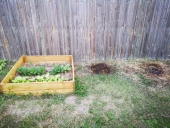
 2
2




 1
1




 2
2




Marianne
check us out @ www.cricketscove.net




 2
2




 2
2




 ), allow me to fasten the sides of the bed together at the top course. Also, while at the lumberyard checked availability of mix for concrete, as I figure to pour some of the block cores. I have an electric mixer stashed in a neighbor's outbuilding, that will be something of a chore to retrieve, but well-worth it, I suspect.
), allow me to fasten the sides of the bed together at the top course. Also, while at the lumberyard checked availability of mix for concrete, as I figure to pour some of the block cores. I have an electric mixer stashed in a neighbor's outbuilding, that will be something of a chore to retrieve, but well-worth it, I suspect.
 1
1
















Adrien Lapointe wrote:why a drain?
I would keep the chips to mulch on top of the bed.
 1
1




 1
1




 1
1




 1
1




 2
2




Adrien Lapointe wrote:One potential issue with the stick technique in drier climates is that the stick could act as a wick and dry out the bed.
 1
1




 1
1




 2
2




 1
1




 1
1




 1
1




 2
2




Zone 3b, Lower St. Lawrence, Quebec
 2
2




 Every vibe I have is it ought to work. Watering is not an issue, there's a pond on the place, and a pump and system in place.
Every vibe I have is it ought to work. Watering is not an issue, there's a pond on the place, and a pump and system in place.









|
Morgan Freeman narrated the birth and life of this tiny ad:
montana community seeking 20 people who are gardeners or want to be gardeners
https://permies.com/t/359868/montana-community-seeking-people-gardeners
|







